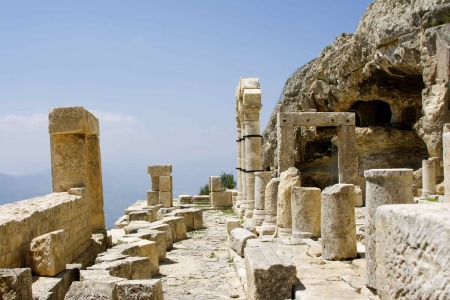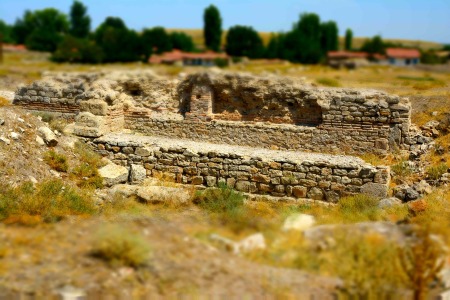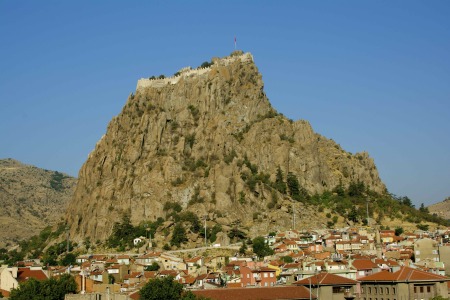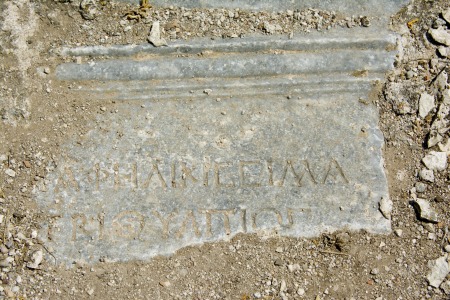The end of the adventure approacheth
 Wednesday, August 20, 2014 at 9:58AM
Wednesday, August 20, 2014 at 9:58AM The journey is nearly over.
In the past three weeks, I’ve visited more than 40 Roman and Byzantine-era sites. Driven more than 2500 The Alahan Monastery, high in the Taurus Mountains near Mut kilometers. Taken at least 3,000 pictures, and filled a 300-page journal and most of a college composition book with notes on what I’ve seen. Spoken to archaeologists, historians, nautical preservationists, and many, many Turks and foreign travelers. It’s been a phenomenal adventure.
The Alahan Monastery, high in the Taurus Mountains near Mut kilometers. Taken at least 3,000 pictures, and filled a 300-page journal and most of a college composition book with notes on what I’ve seen. Spoken to archaeologists, historians, nautical preservationists, and many, many Turks and foreign travelers. It’s been a phenomenal adventure.
Rarely have I found direct evidence of life in the Byzantine world of the early 8th century. For the most part, what remnants of the deep past are still evident are either much earlier – Roman, Greek, even Hittite – or later, Seljuk and Ottoman. The Byzantines of the early 8th century were in a period of profound instability and retrenchment. They had little time to build great monuments or establish new settlements. For the most part, they reused and repurposed the great works that came before them. Later, when their civilization recovered some of its former glory and established secure borders, they would again create astounding works of art and architecture – the mosaics of Chora Monastery, for example, or the frescoes in the Dark Church in Göreme. To judge by the remaining archaeological evidence – what has been unearthed to date, at least – the Byzantines of the early 8th century lived in a time when economic disaster, plague, invasion, loss of territory, and a series of massive earthquakes in the 6th and 7th centuries had reduced their world to a state of constant instability.
 Part of the ongoing excavations at Amorium, capital of the Byzantine Anatolikon themeAnd yet… I’ve come to believe – and some emerging archaeological and multi-disciplinary research on complex adaptive systems seems to support this view – that the so-called Dark Ages of Byzantium were not completely dark. Constantinople, for example, may have had a much smaller population in the early 8th century than it did in, say, the early years of Justinian I’s reign, 150 or so years before. Large areas of the city had been given over to orchards and vegetable gardens, the great monumental buildings were sometimes not maintained, little new building was going on aside from repairs to the defensive walls, and the mansions of earlier generations of the aristocracy may have been subdivided into smaller apartments. Yet this makes sense for a city adapting to vastly different circumstances – we just have to look at Detroit for a contemporary comparison. Over time, the Byzantines repurposed the structures of the great city Constantine had built and made them relevant to their new circumstances. In the process, they made the city more self-sufficient and resilient in the face of threat. A city with a smaller population and its own resources for food production – orchards, gardens, fisheries – is much more able to withstand external threat than is one bursting at the seams with overpopulation, dependent upon distant provinces for its basic sustenance, with sprawling suburbs outside the city walls whose people would swell the already overwhelming numbers of hungry mouths inside the defenses in times of crisis.
Part of the ongoing excavations at Amorium, capital of the Byzantine Anatolikon themeAnd yet… I’ve come to believe – and some emerging archaeological and multi-disciplinary research on complex adaptive systems seems to support this view – that the so-called Dark Ages of Byzantium were not completely dark. Constantinople, for example, may have had a much smaller population in the early 8th century than it did in, say, the early years of Justinian I’s reign, 150 or so years before. Large areas of the city had been given over to orchards and vegetable gardens, the great monumental buildings were sometimes not maintained, little new building was going on aside from repairs to the defensive walls, and the mansions of earlier generations of the aristocracy may have been subdivided into smaller apartments. Yet this makes sense for a city adapting to vastly different circumstances – we just have to look at Detroit for a contemporary comparison. Over time, the Byzantines repurposed the structures of the great city Constantine had built and made them relevant to their new circumstances. In the process, they made the city more self-sufficient and resilient in the face of threat. A city with a smaller population and its own resources for food production – orchards, gardens, fisheries – is much more able to withstand external threat than is one bursting at the seams with overpopulation, dependent upon distant provinces for its basic sustenance, with sprawling suburbs outside the city walls whose people would swell the already overwhelming numbers of hungry mouths inside the defenses in times of crisis.
What ruins I did find that were directly attributable to my period or that would clearly have been in continuous The ancient citadel at Afyon (Akroinon), which goes back at least as far as the Hittites occupation throughout it – say, the great city of Amorium, or Syllaeum (Syllium) on the Pamphylian plain – show that the Byzantines had not lost the ability to thrive and build upon the inheritance of their forebears, where the circumstances allowed. Elaborate stonework is in evidence at Amorium, a city built in the early Byzantine period that was the capital of the Anatolikon theme – the strongest and most strategically vital of all the Byzantine provinces – throughout the period I’m researching. Syllaeum awaits serious excavation, which may reveal many heretofore hidden secrets about its progression from Hittite stronghold to Greek city-state to Roman town to Byzantine fortress, and onward. Even inside Constantinople, sites like the Yenikapı harbor excavations reveal that maritime trade may have continued to thrive, albeit perhaps on a more regional scale compared to the height of the Roman era. Other sites relevant to the early Byzantine period, such as the church of St. Mary of Chalkoprateia in Istanbul, have yet to be retrieved from their currently neglected state – in this case, hidden behind a sidewalk café, used as a lighting backdrop and otherwise left to crumble into further ruin – remain to be explored.
The ancient citadel at Afyon (Akroinon), which goes back at least as far as the Hittites occupation throughout it – say, the great city of Amorium, or Syllaeum (Syllium) on the Pamphylian plain – show that the Byzantines had not lost the ability to thrive and build upon the inheritance of their forebears, where the circumstances allowed. Elaborate stonework is in evidence at Amorium, a city built in the early Byzantine period that was the capital of the Anatolikon theme – the strongest and most strategically vital of all the Byzantine provinces – throughout the period I’m researching. Syllaeum awaits serious excavation, which may reveal many heretofore hidden secrets about its progression from Hittite stronghold to Greek city-state to Roman town to Byzantine fortress, and onward. Even inside Constantinople, sites like the Yenikapı harbor excavations reveal that maritime trade may have continued to thrive, albeit perhaps on a more regional scale compared to the height of the Roman era. Other sites relevant to the early Byzantine period, such as the church of St. Mary of Chalkoprateia in Istanbul, have yet to be retrieved from their currently neglected state – in this case, hidden behind a sidewalk café, used as a lighting backdrop and otherwise left to crumble into further ruin – remain to be explored.
 A half-buried inscription at AmoriumI’m certain that if the same kind of passion and resources that the archaeological and historical communities have devoted to the Greek and Roman eras were applied to Byzantine sites, we could learn much about the lives of these people struggling to adapt to rapid changes in their economic, social, religious, geopolitical, and even ecological environments. I have no doubt that much of what we’d find would challenge pre-existing assumptions about the “Dark Ages” of Byzantium.
A half-buried inscription at AmoriumI’m certain that if the same kind of passion and resources that the archaeological and historical communities have devoted to the Greek and Roman eras were applied to Byzantine sites, we could learn much about the lives of these people struggling to adapt to rapid changes in their economic, social, religious, geopolitical, and even ecological environments. I have no doubt that much of what we’d find would challenge pre-existing assumptions about the “Dark Ages” of Byzantium.
Meanwhile, for lack of the wealth of evidence that I would have found were my book set, say, 7 centuries earlier, I must rely on my own imagination and the work of a few pioneers in early Byzantine studies to re-create the world in which my characters might have lived. This journey has provided invaluable fuel for that leap of the imagination. All that’s left now is to tell the story.
“All.” As if that weren’t everything.
As of today, I have a complete draft of Part One. Part Two awaits when I return home. Onward.
Some of the better pictures I've taken over the course of my 2500km journey from Antalya to Cappadocia can be found here.